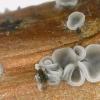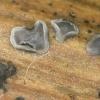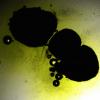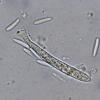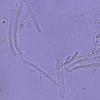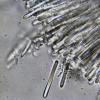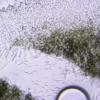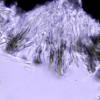
06-12-2025 00:19
 Viktorie Halasu
Viktorie Halasu
Hello, would anyone have this article, please? An

05-12-2025 17:33
 Bruno Coué
Bruno Coué
Bonjour, je serais heureux de recueillir votre avi

02-12-2025 18:59
This pair of ascos 2.5cm across were on recently b

02-12-2025 19:25
Buckwheat PeteHello, can anyone identify this hairy fungus growi

30-11-2025 12:53
 Edvin Johannesen
Edvin Johannesen
White short-stipitate apothecia found on thin twig

30-11-2025 10:47
 William Slosse
William Slosse
I recently found a collection of small Peziza sp.
 Hi,
Hi,Found in March on last years stick from Rubus idaeus, Denmark.
Apotecia: Do not seem to be erumpent, sessile, smooth grey disk, with anchoring hyphae, bright yellow colour extracted with KOH.
Asci: IKI+, I think with croziers, approx. 53 (40-55) x 5-5,5 my.
Ascospores: 1-celled, mostly clavate, 10,2 (8,3-12,4) x 2,1 (1,7-2,5) my, Q=4,9 , n=20. With some droplets.
Paraphyses: Cylindrical, 3 my wide, with large light diffracting LBs.
Excipulum: Mostly roundish dark cells, some dark hairlike cells seen.
Any help much appreciated.
Kind Regards
Mathias

Yours, Lothar


Hier kannst Du wertvolle Infos lesen:
https://asco-sonneberg.de/pages/gallery/mollisia-revincta-epilobium-koh-110910-01xs21751.php
Dort steht u.a. auch:
Auf die KOH-Reaktion kann man sich wahrscheinlich nicht gut verlassen. Zwar ist sie meist mittelstark und vergänglich, jedoch sind mir von Rubus auch stark gelbe und anhaltende Reaktionen bekannt
Dein Fund ist ja von Rubus.



Yours, Lothar



Mollisia revincta is a complex of species with small spores on herbaceous stems. According to my own collections there are quite many genetically different species which I used to "determine" as revincta. There are collections with strong and with weak yellow reaction and even without. I did not study that complex ion detail, but I'm convined that Mollisia clavata is a different species characterized by the marginal cells. What concerns Mollisia alcalireagens, there is the problem that the i examined the holotype collection PRM899458 and found it to be completely KOH-negative (also NH3-negative). I don't know how to interprete this. On the other hand I have collections from Rubus which are strng yellow whereas collections from Filipendula (which I think to be the "true" revincta" are usually only weakly positive.
No great information all in all, I know. That group needs revision ....
all the best,
Andreas

